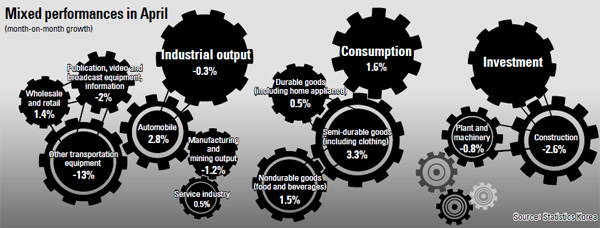April mixed for economy

But it wasn’t all bad news, as the domestic market showed some improvement.
Consumption rose from the previous month, suggesting that the government’s economic vitalization campaign aimed at boosting consumer spending by increasing policy rate cuts, among other measures, is finally showing some results.
According to Statistics Korea and the Ministry of Strategy and Finance on Friday, Korea’s overall industrial output in April fell 0.3 percent compared to the previous month.
This is the second consecutive month that industrial output has retreated, having fallen 0.5 percent in March.
The output from the manufacturing and mining industry saw a sharper fall, down 1.2 percent in April compared to 0.3 percent in March.
Production of automobiles and telecommunications equipment grew compared to the previous month, which was also an improvement from March.
Automobile production grew 2.8 percent, while telecommunication and broadcasting equipment grew 9 percent. Each industry’s output was a turnaround from March, where automobile output declined 0.7 percent month-on-month while telecommunication and broadcasting equipment saw a sharper drop of 14 percent. But other areas, including transportation equipment output, have fallen 13 percent, while metal processing slumped 8 percent.
Investment has also dropped for the second consecutive month. Investment in plants and machinery, which fell 2.7 percent in March, retreated 0.8 percent in April. Investment in construction also fell 2.6 percent last month.
While industrial output struggled, the domestic market fared well. In fact, spending has improved from a 0.5 percent decline in March to a 1.6 percent increase in April. Spending on durable goods, semi-durable goods like clothing and even non-durable goods like food and beverages all increased.
Spending at convenience stores saw the sharpest growth of 9.4 percent, and increased 5.9 percent at major discount stores. Spending at department stores, on the other hand, fell 2.1 percent.
“The domestic market is surely showing strong improvement in areas like spending,” said a Finance Ministry official. “However, industrial output and investment recovery seems to be held back, largely affected by decelerating exports.”
The Finance Ministry, under the incumbent minister and former Saenuri lawmaker Choi Kyung-hwan, has been pushing for economic recovery propelled by the recovery of the domestic market rather than exports. In achieving its target, the Bank of Korea since August has cut the policy rate three times, most recently in March. The recovery in April is considered the beginning, as BOK Gov. Lee Ju-yeol earlier projected that the results of the rate cut will become more visible starting in the second quarter.
BY LEE HO-JEONG [lee.hojeong@joongang.co.kr]










with the Korea JoongAng Daily
To write comments, please log in to one of the accounts.
Standards Board Policy (0/250자)